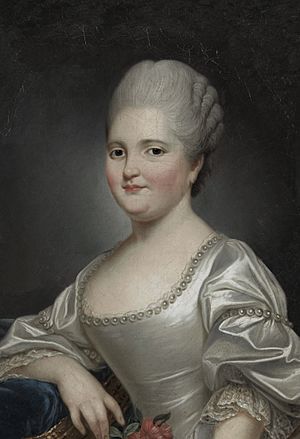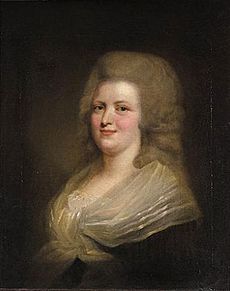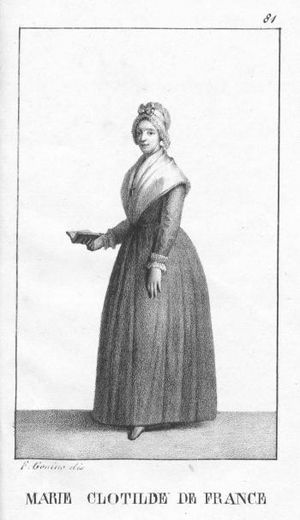Clotilde of France facts for kids
Quick facts for kids Clotilde of France |
|||||
|---|---|---|---|---|---|
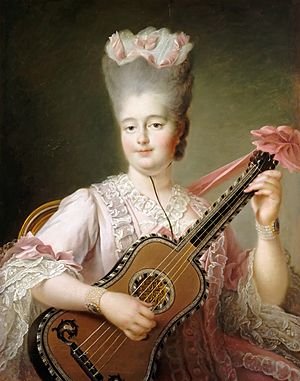
Madame Clotilde playing the guitar, circa 1775.
|
|||||
| Queen consort of Sardinia | |||||
| Tenure | 16 October 1796 – 7 March 1802 | ||||
| Born | 23 September 1759 Palace of Versailles, Versailles, France |
||||
| Died | 7 March 1802 (aged 42) Naples, Italy |
||||
| Burial | 11 March 1802 Church of Santa Caterina a Chiaia |
||||
| Spouse | |||||
|
|||||
| House | Bourbon | ||||
| Father | Louis, Dauphin of France | ||||
| Mother | Maria Josepha of Saxony | ||||
| Religion | Roman Catholicism | ||||
| Signature | |||||
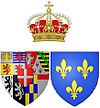 Coat of arms of Queen Clotilde of France |
|||||
Marie Clotilde of France was born on September 23, 1759. In Italy, she was known simply as Clotilde. She became the Queen of Sardinia when she married Charles Emmanuel IV of Sardinia. Clotilde was also the younger sister of King Louis XVI of France. She was very involved in politics and often acted as her husband's main advisor. The Catholic Church honors her as 'Venerable', which is the first step towards becoming a saint.
Contents
Growing Up as a French Princess
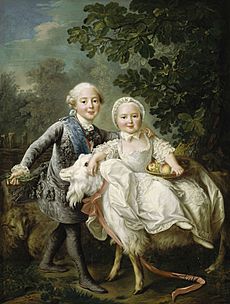
Clotilde was born at the Palace of Versailles in France. She was the older daughter of Louis, Dauphin of France, who was the only son of King Louis XV of France. Her mother was Princess Maria Josepha of Saxony. Because she was the king's granddaughter, she was called a Petite-Fille de France.
In May 1774, her grandfather King Louis XV died. Clotilde's oldest brother, Louis Auguste, then became King Louis XVI of France.
Clotilde and her younger sister Élisabeth were raised by Madame de Marsan. People thought the two sisters had very different personalities. When Clotilde was young, she was a bit overweight. Because of this, she was sometimes called Gros-Madame, which means "Fat Madame".
While Élisabeth was described as "proud" and "passionate", Clotilde was seen as "happy" and "easygoing". They received the usual royal education for princesses. This education focused on skills, religion, and good behavior. Clotilde was said to enjoy her studies. They learned about plants from M. Lemonnier and history and geography from M. Leblond. They also had religious lessons.
Clotilde was a good student and was loved by everyone around her. Élisabeth, however, sometimes refused to study. She believed that princes always had people to think for them. Madame de Marsan, who found Élisabeth difficult, preferred Clotilde. This made Élisabeth jealous.
Their relationship improved when Élisabeth became ill. Clotilde insisted on taking care of her. During this time, Clotilde taught Élisabeth the alphabet and helped her become more interested in religion. Clotilde became Élisabeth's close friend and advisor.
Clotilde did not have a good relationship with her sister-in-law, Marie Antoinette. The Queen openly preferred Clotilde's sister Élisabeth, which caused some tension at court.
Her Royal Marriage
Clotilde became very religious at a young age. She even wanted to become a nun, like her aunt Madame Louise, and join the Carmelite Order.
However, her brother King Louis XVI had other plans. In February 1775, he arranged for Clotilde to marry Charles Emmanuel, Prince of Piedmont. Charles Emmanuel was the oldest son of Victor Amadeus III of Sardinia and Maria Antonia Ferdinanda of Spain.
This marriage was part of a series of alliances between France and Savoy. Charles Emmanuel's sister, Marie Joséphine, had married Clotilde's older brother, the Count of Provence, in 1771. Another of Charles Emmanuel's sisters, Marie Thérèse, had married Clotilde's youngest brother, the Count of Artois, in 1773.
Clotilde did not want to marry, but she accepted her brother's decision. She learned Italian to prepare for her role as a future Queen of Sardinia.
On August 21, 1775, Clotilde was married by proxy in Versailles. This means someone else stood in for the groom. Her second oldest brother, the Count of Provence, acted as Charles Emmanuel's representative.
Clotilde left Versailles on August 27. She said goodbye to the King, Queen, and her sister Élisabeth in Choisy. Their farewell was very emotional. Queen Marie Antoinette noted how upset Élisabeth was, saying she feared getting too attached to her.
In Lyon, Clotilde became popular by asking for an amnesty for imprisoned soldiers. She arrived at the border on September 5. There, she met her new Italian household. This included her new lady-in-waiting, Madama Theresa Balbi, who became her favorite friend.
After crossing the border, she met Charles Emmanuel. She was then introduced to her new in-laws and the Sardinian court. Her formal entrance into Turin was on September 30. The official wedding took place in Turin. Some people in the French court joked about her weight, saying her groom got "two brides instead of one". Her father-in-law worried her weight might affect her ability to have children. However, her groom reportedly said he had been given "more to worship".
Princess of Piedmont
Clotilde quickly built good relationships with her new family. She also became popular with the public. Her father-in-law called her an "angel of peace". This was because she often helped solve arguments between family members, especially between him and her husband.
She easily adapted to the strict court rules of her very Catholic mother-in-law, Queen Maria Antonia. Clotilde took part in all the public duties expected of her as Crown Princess. She showed that she would maintain the strict moral standards at court when she became queen. She was also close to her sisters-in-law.
Clotilde was well-liked by her staff because she was thoughtful towards them. Her strong faith and frequent prayers made her known for her piety among the public. In her early years in Savoy, she enjoyed fashion and entertainment. Even with her saintly reputation, her husband said she had to work hard to be humble and obedient.
Although their marriage was arranged for political reasons, Clotilde and Charles Emmanuel became very devoted to each other. They shared a strong belief in the Catholic faith. She played the guitar while he sang. They studied religious texts together. They also enjoyed relaxing at their country homes to escape court life.
The couple did not have any children. People worried that her weight might be why she couldn't conceive. For several years, she tried different fertility treatments, including a diet that helped her lose a lot of weight. In 1779, there was a false sign of pregnancy. In 1783, after eight years, Clotilde asked Charles Emmanuel if they could live in chastity, like brother and sister. He agreed willingly.
Charles Emmanuel was a quiet person and relied on Clotilde's stronger personality. She became a great influence on him, offering stability and advice. She often helped resolve conflicts between him and his father, the King. These conflicts were often caused by Charles Emmanuel's health challenges. Clotilde made sure to hide his condition from others and help him stay calm.
The French Revolution brought great difficulties for Clotilde's family. Her youngest brother, the Comte d'Artois, left France in 1789. He was allowed to stay in Turin under the protection of her father-in-law, the King of Sardinia. Clotilde also welcomed other French nobles who had fled France. In March 1791, her aunts, Madame Adélaïde and Madame Victoire, also came to stay.
After her brother the Count of Artois left, his wife, the Countess of Artois, became very sad. She thought about becoming a nun. However, Clotilde convinced her not to, reminding her of her duties to her children. During this time, Turin was full of French nobles who had fled. The public in Savoy did not like them. This also made the government in Paris see Savoy as an enemy. Clotilde was in a difficult position because her charity work among the French refugees was noticed.
In the 1790s, the artist Élisabeth Vigée Le Brun described Clotilde as looking and acting very differently. Vigée Le Brun met Clotilde around 1791 or 1792. She noted that Clotilde had changed a lot since she was young.
Vigée Le Brun wrote: "The Queen of Sardinia had her hair cut short and wore a simple cap. Her clothes were also very plain. I was especially struck by how thin she was. I had seen her when she was very young, before her marriage, when she was so stout that she was called 'Fat Milady' in France. This change might have been due to her strict religious practices or the suffering she experienced because of her family's misfortunes. She had changed beyond recognition. The King joined her. He was also so pale and thin that it was painful to look at them together."
Her oldest brother, King Louis XVI, her sister-in-law, Queen Marie Antoinette, and her younger sister, Madame Élisabeth, were all executed in France between 1793 and 1794. Clotilde saw her brother as a Catholic martyr. However, she was more deeply affected by her sister's execution. This event changed her life.
She had hoped that Élisabeth would not be executed because she was not as politically important. So, the news of her execution was a shock. Her husband told her they had to make a sacrifice. Clotilde immediately understood, replied, "The sacrifice is made!" and fainted.
After her sister's death, Clotilde decided to live the rest of her life in penance. From that year until her death, she only wore simple blue woolen dresses. She cut her hair short and covered it with a plain cap. She gave up all her jewelry except for a ring and a cross. She also stopped going to the theater and opera. It was noted that she treated the French Republic's ambassador, Ginguen, with kindness, which surprised some people. She said she considered it a Christian act.
Queen of Sardinia
In 1796, her husband became king, and Clotilde became the Queen of Sardinia. Charles Emmanuel was described as quiet, unsure, and unable to act. The difficult situation of the Kingdom made his health challenges worse, making it hard for him to rule.
He preferred Clotilde to receive reports from ministers and diplomats. She would read them, summarize them for him, and advise him on what to do. Clotilde followed these instructions. She consulted with ministers before giving recommendations to her husband. She also made sure to choose the right moment to involve him in state affairs. This was to avoid causing him more stress or letting the public know about his health issues.
This way of handling government affairs caused delays and made ruling slow, especially during a critical time for Savoy. Although Clotilde was careful not to appear too involved in politics, her great influence was clear and led to some criticism. The King and Queen were also accused of spending too much time on their religious devotions, which further delayed government work.
During their rule in Turin, one important issue was taking over church property. This was necessary for the state's finances. However, Clotilde insisted on a long process to get permission and blessings from the Pope for religious reasons before moving forward.
On December 6, 1798, the French First Republic declared war on Sardinia. Charles Emmanuel was forced to give up all his lands on the Italian mainland. He had to retreat to the island of Sardinia. The royal family was ordered to leave Turin immediately after he gave up his lands. Since the King was having a difficult time, Clotilde organized their departure.
Clotilde left the Crown Jewels behind. However, she took all the jewels that were considered private property. She also accepted money from the Finance Minister after a priest assured her it was religiously acceptable. The family left the royal palace at night, escorted by soldiers. When their wagon was briefly stopped by protesting crowds, Charles Emmanuel told Clotilde that this show of loyalty would comfort him in exile.
During their time in exile from mainland Sardinia, the couple traveled between Italian states and their own provinces. They kept up diplomatic relations, hoping to return to Turin. They arrived in Cagliari, Sardinia, on March 3, 1799. They were welcomed with a special church service and settled in the Royal Palace.
Clotilde was not well during their stay in Sardinia. The woolen clothes she insisted on wearing for penance were not suitable for the hot climate.
During their exile, Clotilde acted as Charles Emmanuel's spokesperson and main advisor. She effectively managed the Sardinian government in exile. She showed great diplomatic skill and steady support for Charles Emmanuel. He refused to give up his position as king as long as she was alive, even though his brothers demanded it. Despite her political activity, Clotilde always downplayed her own role, both publicly and privately. This was seen as more fitting for her piety.
In September 1800, Charles Emmanuel and Clotilde left Sardinia for Florence. They hoped that the alliance against France would help them return to Turin. However, the Battle of Marengo forced them to flee to Rome and then to Naples. They stayed in Naples from November 1800 to March 1801 before returning to Rome. In Rome, they lived as guests of the wealthy Colonna family.
Clotilde cared for her husband's aunt, Princess Maria Felicita of Savoy, during her final illness in Naples in 1801. She also attended to her favorite lady-in-waiting, Badia. During this time, a doctor mistook Clotilde for a servant. She followed his orders without protest or telling him who she was. When he found out and apologized, she did not scold him. This incident gained some attention. The couple finally returned to Naples in May 1801. Besides handling political matters through letters, Clotilde spent her time visiting religious places, churches, and people.
Clotilde died on March 7, 1802. Charles Emmanuel was so saddened by her death that he gave up his throne on June 4, 1802. His younger brother, Victor Emmanuel, became the new king. Queen Clotilde was buried in Santa Caterina a Chiaia in Naples. Pope Pius VII, who knew Clotilde personally, declared her venerable on April 10, 1808. This was the first step towards her beatification, which means being declared a saint.
See also
 In Spanish: Clotilde de Francia para niños
In Spanish: Clotilde de Francia para niños


